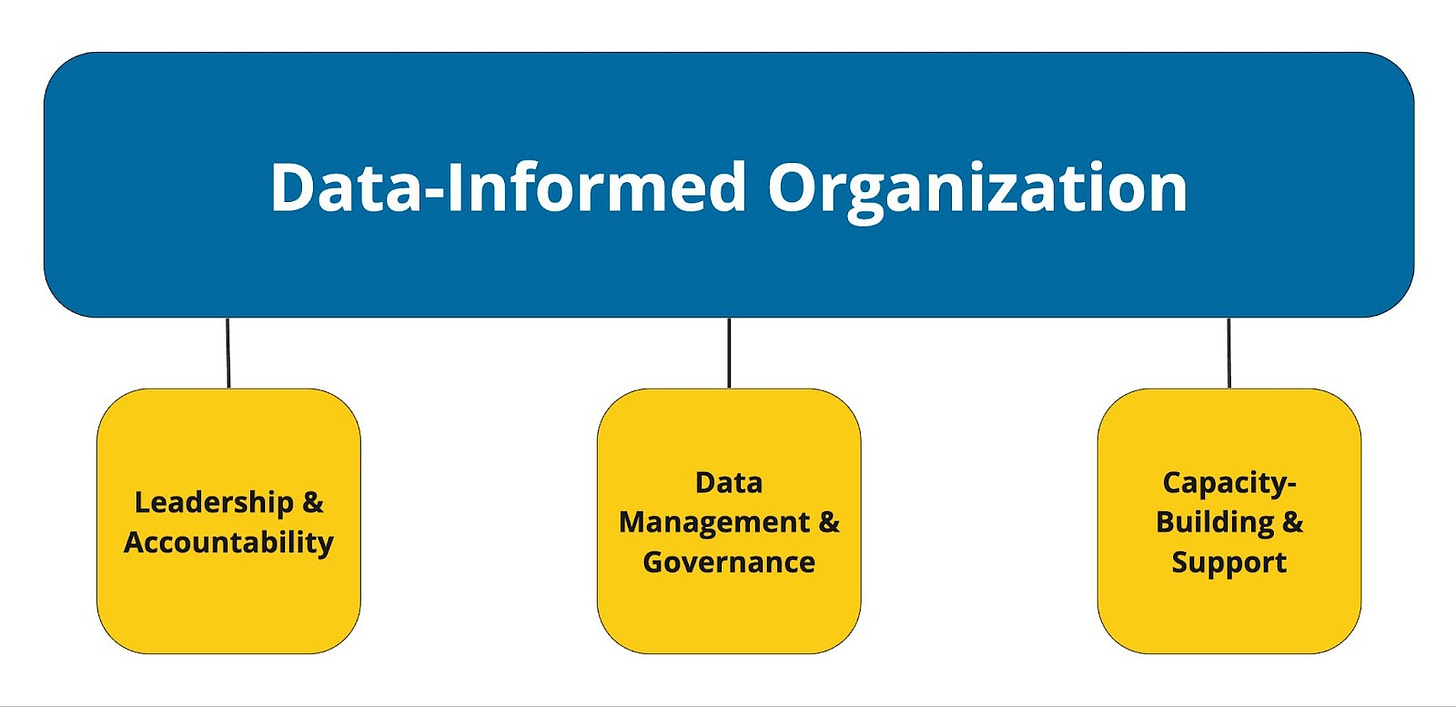Becoming a Data-Informed Organization
A Definition and a Framework
[Short on time? Read the TLDR version.]
It’s easy to talk about how governments and nonprofits need to make better use of data to deliver services, improve efficiency, and communicate with customers. It’s not nearly so easy to understand what’s actually required to do it. In the next few issues I want to break that down.
I’ll start by defining what a data-informed1 organization is and then introduce a simple framework for thinking about how to create and maintain the processes and culture that enable it. In subsequent issues I’ll dig into each element of the definition and framework and explore how it might look in some concrete organizations, both from leadership and practitioner perspectives.
What is a Data-Informed Organization?
It’s about dashboards, right?
Weeeell …
No. It’s not about dashboards and it’s not even primarily about data. More than anything else, being a data-informed organization is about commitment, specifically, a commitment to
Clearly define the specific results or outcomes you want to achieve,
Find objective ways to tell if your efforts are working,
Take action and change course if they are not.
The word “data” doesn’t even appear. While obviously an important part of the process, data is not the point. The point is the results and the commitment to taking action in order to get them.
Most organizations hobble their efforts from the start by failing to clearly define the results they want. Doing that well means articulating concretely what a customer or stakeholder actually experiences or expects.
For example, we may all agree that we want “clean” sidewalks, but does that mean issues are identified and handled automatically as they occur, responded to quickly when someone complains, or dealt with as part of monthly power washing and litter sweeps? Those are all valid responses to the need for clean sidewalks, but are experienced by residents quite differently and require very different resources and organization.
And if you don’t have clarity on that first step, it’s impossible to do the next two steps well.
In future practitioner-oriented articles I’ll share guidance on all three steps, but it is critical for leaders to understand that dashboards and data solve nothing unless they are grounded in these commitments, which require investment of time and effort up front. Being data-informed means being proactive. The good news, of course, is that being proactive saves time and expense in the long run, while also making your organization more effective.
A Framework for Building the Data-Informed Organization
For the vast majority of government and nonprofit organizations, operating as a data-informed organization requires significant culture change. As with any major change, that means more than good intentions and a one-time decision; it requires a deliberate strategy and sustained effort.
The figure below provides a simple framework for thinking about that strategy and effort. Broadly, there are three categories to consider: Leadership & Accountability, Data Management & Governance, and Capacity-Building & Support.
Leadership & Accountability is first and foremost about making sure that data is being used to inform decisions. It is also about ensuring that leaders model the required behaviors and that systems are in place to hold everyone in the organization accountable.
Data Management & Governance is about having the technical and process infrastructure in place to ensure that quality data is available and that there are mechanisms to reduce the risks of harm either through inadvertent release of sensitive information or through data-induced biases that create disparities in outcomes for different groups.
Finally, Capacity-Building & Support is about making training, change management, and technical support available to build the capacity of the whole organization to operate in the new paradigm.
Obviously the details will depend on the organization, but this framework works equally well for a large, multi-departmental organization as for a single department or small organization. The key is to make sure that you are thinking holistically about what is needed to help the organization be successful in its transformation.
In following issues I will dive more deeply into the three commitments and what it means to take them on as an organization, and explore how to use the framework to think about strategies for a concrete organization.
Further Reading
The article above is part of a larger series. Here it is so far:
Becoming a Data-Informed Organization (this article)
tldr
A data-informed organization is one that commits to
Defining the specific results or outcomes to be achieved,
Finding objective ways to tell if its efforts are working, and
Taking action and changing course if they are not.
To accomplish this requires a deliberate strategy and sustained effort in three areas:
Leadership & accountability: modeling the right behavior and holding the whole organization accountable;
Data management & governance: the technical and process infrastructure to ensure data availability and quality and mitigate potential harms;
Capacity-building & support: training, change management, and technical support for the whole organization
To learn more about what I do and how we can work together visit DeepWeave.com.
Why “data informed” rather than “data-driven”? Any important decision requires context and expertise well beyond what is in the data you have. As AI has exploded over the last couple years, the possibility of data-driven decision making has become more real and the risk of problematic outcomes is much higher, so I choose terminology that highlights the importance of context and human perspective.



